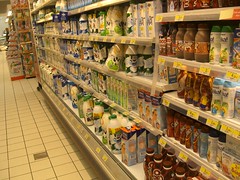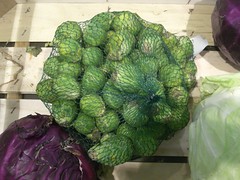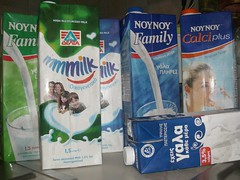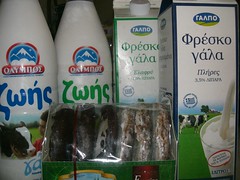In the western world, milk is one of the most revered basic food items: it is the first meal an infant receives as soon as it is born, the only food a human being produces from her own body. Milk is so versatile in its use that it is able to be processed naturally into a huge variety of different kinds of food items - cream, cheese, yoghurt; with the addition of sugar, it becomes one of the most sought-after hot-weather refreshments in the form of milkshakes and ice-creams. It contains a range of nutrients, and has taken on the role of one of the most basic items on the breakfast table. It is simply unimaginable for a Westerner not to have some milk in some form in the morning, whether it's warmed up in a cup of cocoa, tea or coffee, or in a bowl of cereal, or in the form of yoghurt or cheese.
Στο δυτικό κόσμο, το γάλα θεωρείται ένα από τα βασικά τρόφιμα: είναι το πρώτο γεύμα που λαμβάνει ένα βρέφος αμέσως μόλις γεννιέται, το μόνο τρόφιμο που παράγει το ανθρώπινο σώμα. Το γάλα είναι τόσο ευέλικτο και ευπροσάρμοστο στην χρήση του που είναι σε θέση να υποστεί επεξεργασία, δημιουργώντας μια τεράστια ποικιλία από διαφορετικά είδη τροφίμων - κρέμα γάλακτος, γιαούρτι, τυρί μαλακό, τυρί σκληρό, κλπ. Με την προσθήκη ζάχαρης, καθίσταται ένα από τα πιο περιζήτητα αναψυκτικά του καλοκαιριού, το παγωτό. Περιέχει πολλά θρεπτικά συστατικά, και έχει αναλάβει το ρόλο ενός από τα πιο βασικά στοιχεία του πρωινού γεύματος. Είναι αδιανόητο να μην υπάρχει σε κάποια μορφή στο πρωινό μας.
In 2006, the top 20 milk-drinking countries of the world included Greece. In 2003, the country that eats the most cheese per capita was Greece, with feta cheese accounting for 75% of all cheese eaten in Greece. Cows, sheep and goats are all employed in milk, cheese and yoghurt production throughout the country. This information should all lead one to believe that milk is freely available in Greece; unfortunately, that only happens when the milk-producer farmers are dumping it, complaining of low subsidies, low prices and high middleman's prices. Milk prices are generally determined by the demand, supply and agricultural policy system. In Greece, it is the consumer who gets the worst deal; the cost of milk in Greece is absurdly high in comparison to the average salary of a Greek worker. This is why I get very tetchy when my children don't drink all the milk in the glass, or they eat their cornflakes, but leave the milk in the bowl...
Το 2006, η Ελλάδα ήταν ανάμεσα στις 20 χώρες του κόσμου που κρατούσαν την πρωτιά στην κατανάλωση του γάλακτος. Το 2003, η πρώτη χώρα στη κατανάλωση του τυριού ήταν η Ελλάδα: η φέτα αποτελεί 75% όλων των τυριών που καταναλώνονται στην Ελλάδα. Αγελάδες, πρόβατα και κατσίκες, όλα απασχολούνται στον τομέα των γάλακτοκομικών ειδών. Αυτές οι πληροφορίες θα πρέπει να μας οδηγήσουν να πιστεύουμε ότι όλοι έχουν εύκολη πρόσβαση στο γάλα. Δυστυχώς, αυτό συμβαίνει μόνο όταν οι γαλακτοπαραγωγοί αδιάζουν τα δοχεία στο δρόμο, ως ένδειξη διαμαρτυρίας για τις χαμηλές επιδοτήσεις, τις χαμηλές τιμές και τα υψηλά κόστα των μεσάζων. Οι τιμές του γάλακτος γενικά καθορίζονται από τη ζήτηση, την προσφορά και την πολιτική του αγροτικού συστήματος. Στην Ελλάδα, ο καταναλωτής ζημιώνεται πιο πολλή από κάθε άλλον, αφού το κόστος του γάλακτος στην Ελλάδα είναι πολύ υψηλό σε σύγκριση με τις υπόλοιπες χώρες της Ευρώπης, προπαντώς αν λαμβάνει μέρος σ’αυτή τη σύγκριση το μέσο μισθό ενός Έλληνα εργαζόμενου. The milk cost saga has intensified with the recent discovery that melamine was added to milk sold in China, creating a wholly unsatisfactory image of milk, given its importance in the daily diet of people right around the world (thankfully, we've been assured that
no such milk was detected in the milk sold in Hania).
Η πρόσφατη ανακάλυψη ότι προστέθηκε μελαμίνη στο γάλα που πωλείται στην Κίνα δημιουργεί μια εικόνα καθόλου ικανοποιητική για το γάλα, λόγω της μεγάλης σημασίας στην καθημερινή διατροφή των ανθρώπων σε όλο τον κόσμο (ευτυχώς, έχει διαβεβαιωθεί ότι δεν εντοπίστηκε τέτοιο γάλα να πωλείται στα Χανιά). We are constantly bombarded with TV and newspaper reports claiming that Greece has the highest price for milk per litre in the whole of Europe; it is also claimed that the price of a litre of milk in Greece is much higher than other countries where there is a high level of milk consumption, such as the USA, Australia and New Zealand.
I've also seen prices floating around on the internet for the price of milk in Greece, and they do seem rather high. But what I haven't seen anywhere (except in one free monthly newspaper published in Hania, "Καταναλωτής" -
katanalotis, meaning 'consumer') is a price index of the cost per item listed by brand name and supermarket chain (because, let's face it, most of us do our shopping there).
Βομβαρδιζόμαστε συνεχώς από τα δελτία ειδήσεων που ισχυρίζουν ότι η Ελλάδα έχει την υψηλότερη τιμή του γάλακτος ανά λίτρο σε ολόκληρη την Ευρώπη. Υποστήριζετε επίσης ότι η τιμή του γάλακτος άνα λίτρο στην Ελλάδα είναι πολύ ψηλή.
 (INKA - left - and MARINOPOULOS milk counters)
(INKA - left - and MARINOPOULOS milk counters)Here are some 'tricks' to watch out for:
- TV reports blaring out the word 'milk' on the screen with an extortionist's price tag next to it seem to treat milk (and other food staples like bread) as if it is something akin to Coca-cola, a brand name, or a frappe coffee at a cafe; neither are basic products or staples!!!
- The phrase 'the price of milk' does not denote a brand name; but milk is never sold brand-less, as it used to be in other parts of Europe, in a plastic bag tied at the top!!!
- generic supermarket packaged milk is much cheaper than any of the milk brands sold at a supermarket, and it is always lower than 1 euro, the benchmark price used during last summer's milk boycott, in which consumers were asked to boycott milk brands that were being sold upwards of 1 euro per litre.
- What kind of milk are those reports talking about? Fresh short-life milk (lasts up to five days from date of bottling)? Fresh long-life (ie highly pasteurised; lasts at least three weeks from date of bottling) milk? UHT milk (can be left at room temperature till it is opened, and lasts a year from time of bottling)? Canned milk (became specially popular after the Chernobyl crisis, when it was believed that people's health might be at risk from the contamination of the earth)? Special category milk, eg infants' formula, Ca-fortified, cholesterol-lowering, etc (which is, of course, sold at a premium)?
Milk is not just 'milk' these days.
• Το γάλα είναι βασικό προϊόν: η τιμή του δεν μπορεί να συγκριθεί με την τιμή τιμή της Coca-Cola, ή του φραππέ που πίνουμε στην καφετέρια!
• Η φράση «η τιμή του γάλακτος» δεν χαρακτηρίζει εμπορική ονομασία. Όταν αγοράζουμε γάλα, ειναί πάντοτε συσκευαζμένο. Δεν πωλείται ποτέ χωρίς συσκευασία, οπότε ποιά μάρκα ενοούν τα δελτία όταν λένε ότι αγοράζουμε το γάλα σε μια συγκεκριμένη τιμή;
• Το γάλα που πωλείται με την ονομασία του σούπερμάρκετ είναι πολύ φθηνότερη από οποιοδήποτε άλλα γάλατα που πουλάει η ίδια αλυσίδα σούπερμάρκετ, συνήθως λιγότερο από 1 ευρώ, η τιμή αναφοράς που χρησιμοποιούνταν κατά τη διάρκεια του περασμένου καλοκαιριού στο μποϊκοτάζ των γαλακτος, στον οποίο οι καταναλωτές καλούνται να μποϋκοτάρουν το γάλα που πωλείται άνω του 1 ευρώ ανά λίτρο.
• Για ποιο γάλα μιλάμε; Φρέσκο γάλα μικρής διάρκειας (μπορεί να διαρκέσει έως και πέντε ημέρες από την ημερομηνία εμφιάλωσης); Φρέσκο γάλα μακράς διαρκείας (δηλαδή υψηλής παστερίωσης - διαρκεί τουλάχιστον τρεις εβδομάδες από την ημερομηνία εμφιάλωσης); Γάλα UHT (μπορεί να μείνει σε θερμοκρασία δωματίου μέχρι που το ανοίξετε, και διαρκεί ένα χρόνο από την στιγμή της εμφιάλωσης); Γάλα κονσέρβας; Ειδική κατηγορία γαλακτος, όπως π.χ. γάλα για βρέφη, εμπλουτισμένο γάλα, κλπ (τα οποία φυσικά πωλούνται αρκετά);
Το γάλα δεν είναι πια απλή λέξη στις μέρες μας.
SUPERMARKETS in HANIA
In Hania, a summer resort town which turns into an agricultural production unit in the winter (
unemployment is lower here than other areas of Greece, and people tend to be more affluent), with a
population of about 60,000 in the greater area (which increases ten-fold in the summer with tourists), we have two major supermarket chains serving the greater area:
INKA (the only
local chain) and
CARREFOUR (the former
Champion-Prisunic stores, aka
MARINOPOULOS). Their prices are similar for many products.
Σουπερμάρκετ της ΧANIA
Στα Χανιά, μια πόλη που μετατρέπετε σε θέρετρο το καλοκαίρι και γεωργική μονάδα παραγωγής τον χειμώνα, με πληθυσμό περίπου 60.000 στην ευρύτερη περιοχή (η οποία αυξάνεται επί δέκα φορές το καλοκαίρι), έχουμε πολλές αλυσίδες σούπερμάρκετ που εξυπηρετούν την ευρύτερη περιοχή. Από τον έρευνα, φάνηκε ότι οι τιμές μεταξύ αλυσιδών δεν διαφέρουν πολύ στις τιμές του γάλακτος.

.
LIDL supermarket in Hania, selling brussel sprouts and children's ski suits; Brussel sprouts are NOT grown in Crete, and most Cretans would be hard-pressed to imagine how such a vegetable grows. I was very lucky to have seen them growing in the middle of winter in a garden in Colchester, England. Moreover, it doesn't snow here, while our mountain range, Lefka Ori, does NOT have a ski centre! LIDL (a German discount supermarket chain) sells many products suitable for and familiar to Northern Europeans; no wonder many tourist residents in Hania often do their supermarket shopping here, especially since they are used to spending much less of their monthly income on food items than the average Greek. Given that Greeks exhibit the typical consumer society habit of buying what they don't need, they are the perfect targets for German products that may have not sold well in Germany. The locals of the town never knew what an advent calendar was until the advent of LIDL...I prefer to shop at
INKA, which always stocks local produce at reasonably good quality, although I've found MARINOPOULOS to be slightly cheaper for some generic products. There are also other supermarket chains operating in Hania, such as
LIDL, DIA, SPAR (under the name
CHALKIADAKIS); these chains are
not as widespread as
INKA and MARINOPOULOS (I went to Spar once in the last six months, while i have never used DIA). The pricing policy may differ between supermarkets, but milk has become a
known-value item (
KVI as it's known in the trade), especially since the milk boycott; a store selling it at too high a price would earn the nickname '
farmakeio' (drugstore).
MILK TYPESIn our house, we need a litre of milk per day in the summer months, rising to 1.5 litres in the winter. Being the chief cook and shopper in my household, I should be an expert in supermarket prices, and how to choose what I'm going to buy from the wide range of milk types available. So why do you see so many different brands of milk on my kitchen counter?
- 'Blue' milk - 3.5% fat - is for the children;
- 'Green' milk - 1% fat - is for the adults;
- Calcium-enriched milk for yiayia (she has osteoporosis);
- I always look out for specials on milk, which occur frequently as various brands compete against each other;
- I buy a mixture of brands to make sure I'm not buying only the cheapest product, but also a better quality (price is often associated with quality, not just in psychological terms) whenever I can afford it, but I do not buy milk that costs more than 1.50 euro per litre (a litre of petrol costs less than this!!), as I consider it a luxury product, given the benchmark set during the 2008 milk boycott, urging consumers to buy milk sold at no more than 1 euro per litre;
- I hardly ever buy fresh short-life milk, as it is always imported from the mainland, it never reaches Hania the day it was packed, and given it's five-day-maximum use-by date, we might not consume it before its expiry date. In any case, I would have to go to the supermarket on a daily basis to ensure that we are adequately supplied with milk if I were to use short-life fresh milk on a regular basis.

 A range of milk products, all sold as 'fresh', with prices ranging from 0.98 to 3.05 euro, from three different supermarkets in Hania. The gingerbread biscuits in the right-hand photo were bought at LIDL, in the futile hope that my family might appreciate my taste in sweets...
A range of milk products, all sold as 'fresh', with prices ranging from 0.98 to 3.05 euro, from three different supermarkets in Hania. The gingerbread biscuits in the right-hand photo were bought at LIDL, in the futile hope that my family might appreciate my taste in sweets...:
November 11-14, 2008Only
refrigerated milk is investigated; all other packaged milk (
UHT, canned, powder) is inferior to refrigerated fresh milk, and this is what was being referred to during the milk price boycott; this is also the kind of milk that the media focuses on when they report rising milk prices. There is a
0.01-0.02 cent difference between
INKA and
MARINOPOULOS. All prices were calculated from the
largest packaging available for each brand, and are presented as
the euro price per litre. Milk produced in Greece is clearly stated; we all prefer a home-grown product over an imported one.
Τιμές του γάλακτος
Ο έρευνας έγινε τον Νοέμβριο 11-14, 2008. Μόνο τα γάλατα ψυγείου διερευνούνται (δηλ. όχι UHT, κονσέρβες, σκόνη. Αυτό είναι το είδος γάλακτος που τα ΜΜΕ επικεντρώνονται όταν συζητούν την τιμή του γάλακτος. Υπάρχει μια διαφορά μεταξύ 0,01-0,02 λεπτά μετζξύ τις αλυσίδες σουπερ μάρκετ. Όλες οι τιμές υπολογίζονται από τις μεγαλύτερες συσκευασίες που διατίθενται για κάθε μάρκα, οι οποίες παρουσιάζονται ανά λίτρο. Το γάλα που παράγεται στην Ελλάδα κατονομάζεται, αφού είναι σαφώς ότι όλοι προτιμούν ένα εγχώριο αντί για εισαγόμενο προϊόν. It may be a fact that a single person who only needs up to a litre of milk a week will not be able to buy fresh milk at this price, since they are more likely to prefer to buy a smaller quantity sold at a more expensive price, but that's the cost of single living; I could complain about
frontistiria prices instead...
Είναι γεγονός ότι ένα μόνο πρόσωπο το οποίο χρειάζεται μέχρι ένα λίτρο γάλα την εβδομάδα δεν θα είναι σε θέση να αγοράσει φρέσκο γάλα σε αυτή την τιμή, δεδομένου ότι είναι πιο πιθανό να προτιμά να αγοράζει μια μικρότερη ποσότητα που πωλείται σε ακριβότερη τιμή.DELTA Greek short-life; DELTA (trading under the VIVARTIA conglomerate) is one of the leading milk distributors in Greece.
| 1.30
|
| Lidl GALPO Greek own-brand* short-life; LIDL is a discount supermarket, whose quality is checked according to German standards. The food products are not always of the highest quality, but it is known to stock mainly own-brand products at very cheap prices. | 0.90
|
OLYMPUS Greek short-life; OLYMPUS is a small company based in Trikala (Northern Greece). According to recent laboratory checks, it is believed to maintain an extremely high quality in milk production, and has gained points over its immediate competitor, DELTA. Their packaging is also more appealing: bottles rather than tetrapaks.
| 1.61**
|
DELTA MMMILK long-life; this milk is being sold with a 0.30c discount since summer.
| 1.23
|
NOYNOY FAMILY long-life; NOYNOY (trading under the Friesland conglomerate) is one of the leading milk distributors in Greece. It took FAGE's place in the competition between milk companies after FAGE stopped trading in fresh milk. The milk is of German origin, not Greek.
| 1.35
|
FAGE GALA-10 Greek long-life; FAGE was once one of the leading fresh milk distributors in Greece. It opted out of the fresh milk trade, due to the fierce competition associated with this line of business, and now deals in all other milk products except short-life fresh milk. They also sell their milk in bottles rather than cartons.
| 1.35
|
FAGE FARMA long-life; this milk is being sold with a 0.30c discount since summer.
| 1.08
|
Carrefour ALPS own-brand* long-life; Marinopoulos own-brand.
| 0.91
|
| MEVGAL "Your milk every day" long-life; this milk replaced MEVGAL's original Greek product, being sold at 1.48c per litre. During the milk boycott, MEVGAL was selling it with a 0.50c discount. It was clearly profitably unviable, and MEVGAL ceased producing it. The current product, of German origin, has a similar packaging. | 0.98
|
OLYMPUS BIO long-life; organic, 'bottle'.
| 1.99**
|
| MEVGAL Ariani long-life; buttermilk, 'bottle'. | 1.79**
|
| NOYNOY Calci-milk long-life; calcium-fortified. | 2.03**
|
DELTA Daily long-life; sold in different coloured packaging, each one making various claims as a specialised milk product; 'bottle'.
| 2.20**
|
KRIARAS fresh goat's milk short-life; this is the only fresh milk product made in Crete, using non-bovine milk. All other fresh milk sold in Cretan supermarkets is produced from cow's milk.
| 2.40**
|
| DORNA BIO long-life; this Greek-Swiss company (Romanian milk) originally starting selling this organic milk at a very cheap price (1.44). It also carried 2-for-the-price-of-1 promotions. I bought it regularly until it suddenly raised its prices practically overnight (about a year ago), and the 2-for-1 offers ceased... | 1.89**
|
OLYMPUS ZOIS (LIFE) long-life; this Greek product was being sold with a 330ml orange juice giveaway, whose value did not exceed 0.60c. As our oranges in the village are not yet ripe, this was a chance for me to procure some fresh juice. Yet more bottled milk as well as bottled juice...
| 1.58**
|
* INKA does not have its own brand fresh milk** These products are being sold at a premium price, over 1.50 euro per litre, which is much more than the cost of a litre of petrol. ΔΕΛΤΑ* – μικρής διαρκείας. – 1,30
ΓALΠO* – μικρής διαρκείας. – 0,90
OΛYMΠΟΣ* – μικρής διαρκείας. – 1.61**
ΔΕΛΤΑ MMMILK – μακράς διαρκείας – 1.23
NOYNOY FAMILY – μακράς διαρκείας – 1.35
ΦAΓE ΓΑΛΑ-10 – μακράς διαρκείας – 1.35
ΦAΓE ΦΑΡΜΑ – μακράς διαρκείας – 1.08
Carrefour Άλπες – μακράς διαρκείας – 0,91
ΜΕΒΓΑΛ Εχεις γάλα – μακράς διαρκείας. 0,98
OΛYMΠΟΣ BIO – μακράς διαρκείας, βιολογικό – 1.99**
ΜΕΒΓΑΛ Αριανι – μακράς διαρκείας – 1.79**
NOYNOY Calci – μακράς διαρκείας, εμπλουτισμένο με ασβέστιο – 2.03**
ΔΕΛΤΑ Daily – μακράς διαρκείας – 2,20**
ΚΡΙΑΡΑΣ* φρέσκο κατσικίσιο γάλα – μικρής διάρκειας – 2.40**
ΔΟΡΝΑ – μακράς διαρκείας, βιολογικό – 1.89**
OΛYMΠΟΣ ΖΩΗΣ – μακράς διαρκείας – 1.58**
*Ελληνικά γάλατα
** Τα προϊόντα αυτά πωλούνται σε τιμή πριμ, πάνω από 1,50 ευρώ το λίτρο, που είναι πολύ μεγαλύτερο από το κόστος ενός λίτρου βενζίνης.
CONCLUSIONS- An average price for milk according to the above table (NOT including any of the products being sold at premium prices) is 1.14 per litre of fresh milk, in an affluent Greek island town, transportation costs included. It is well below what is being reported by the mass media. This is what I am actually paying, since I buy all types of milk in the non-premium price range, taking advantage of discounts and special offers. If I simply stuck to the cheapest range of refrigerated milk available, it would still be less than 1 euro per litre, 0.90-0.98 to be precise, in the three supermarkets I frequent.
- The longer the shelf-life, the higher the pasteurisation process.
- The more local the production unit, the more expensive it is.
- The more expensive milk is, the more likely it is to be sold in bottles than tetrapaks, the latter being much easier to dispose; they can be folded down, whereas the plastic bottles used for milk packaging cannot even be crushed. Your rubbish bin will fill up in next to no time with air...
- The more specialised the milk product, the more expensive it is.
- Milk produced furthest away from the selling point is usually the cheapest.
ΣΥΜΠΕΡΑΣΜΑΤΑ
• Ο μέσος όρος των τιμών του γάλακτος, σύμφωνα με τον πίνακα (μη συμπεριλαμβανομένου τα προϊόντα που πωλούνται άνω του 1.50 λίτρου άνα κιλό) είναι 1,14 ευρώ ανά λίτρο φρέσκου γάλακτος. Είναι πολύ πιο κάτω από αυτό που αναφέρεται από τα μέσα μαζικής ενημέρωσης. Αν απλά αγοράζουμε το φθηνότερο γάλα που διατίθεται στο ψυγείο, θα εξακολουθούσε να είναι μικρότερο του 1 ευρώ ανά λίτρο, 0,90-0,98 για την ακρίβεια, στα τρία σούπερ μάρκετ όπου έγινε ο έρευνας.
• Όσο πιο μεγάλη διάρκεια, τόσο υψηλότερη είναι η διαδικασία παστερίωσης.
• Όσο πιο τοπική η μονάδα παραγωγής, τόσο πιο ακριβό είναι.
• Όσο πιο ακριβό το γάλα, το πιο πιθανό να πωλείται σε φιάλες μπουκαλιο΄θ αντί για tetrapaks, η οποία συσκευασία είναι πολύ πιο εύκολη να πετάξετε.
• ‘Οσο πιο εξειδικευμένο το γαλακτοκομικό προϊόν, τοσο πιο ακριβό είναι.
• Το γάλα που παράγεται πιο μακρυά από το σημείο πώλησης είναι συνήθως το φθηνότερο.
The cost of living is generally lower on an island, but so are the salaries. Many agricultural products are cheaper because people often grown their own; milk is only available cheaply to people who have milk-producing animals on their property. We have orange and olive trees, and a well-maintained garden, but no animals; therefore, we buy 'imported' milk in the same way that someone on the mainland buys it: in a tetra-pak or plastic bottle. If anything, packaged milk should be more expensive on an island than in an Athenian supermarket if transportation costs raise prices. So, which milk do you buy?
Το κόστος ζωής είναι γενικά χαμηλότερο σε ένα νησί. Πολλά γεωργικά προϊόντα είναι φθηνότερα γιατί οι άνθρωποι συχνά καλλιεργούν τα δικά τους. Το γάλα διατίθεται φτηνά μόνο σε ανθρώπους που έχουν ζώα παραγωγής γάλακτος για την ιδιοκτησία τους. Το συσκευασμένο γάλα θα πρέπει να είναι πιο ακριβό σ’ένα νησί απ'ό,τι πωλείται σε αθηναϊκό σούπερ μάρκετ αν το κόστος μεταφοράς αυξάνει τις τιμές. Αυτό δεν ενδεικνύεται από τον έρευνα.
©All Rights Reserved/Organically cooked. No part of this blog may be reproduced and/or copied by any means without prior consent from Maria Verivaki.


























